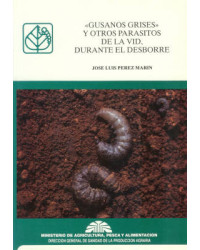- Unavailable



Visa, MasterCard, Amex, Paypal or 3 times, interest-free with Scalapay

0.01€ from 35€ of purchase in France and from 99€ throughout Europe

Delivery in France and around the world at home, at office or in a pickup point

By Jose Luis Perez Marin
ABSTRACT
The grey worms, lepidopterans belonging to the Noctuidae family, caused damage in the vineyards of La Rioja in the 1980s, affecting up to 60% of the buds in phenological states C and D in some cases.
The most frequently observed species were Agrotis segetum Den. & Schiff., Agrotis exclamationis L., and Agrotis ipsilon Huf..
The damage is caused by the larvae and is manifested by bites on the buds in the shape of a crescent moon.
The opportune moment for treatment is phenological state B/C, upon observing the first symptoms, using various application techniques: bait, spraying, or granules on the ground. The following active ingredients stand out for their effectiveness: chlorpyrifos, deltamethrin, acephate, cyfluthrin, monocrotophos, methomyl, trichlorfon, and endosulfan. The presence of another pest known as erinosis has also been observed during bud break, caused by the mite Calepitrimerus vitis Nal., which generally causes more damage than the grey worms. Its symptoms are manifested on the leaves by whitish spots and vegetative retention, and the opportune moment to combat them is phenological state C/D, using organophosphates in spraying, or from phenological state D with the use of active ingredients such as endosulfan, methidathion + bromopropylate, tetradifon + dicofol + omethoate, bromopropylate, dicofol, or dicofol + tetradifon.
ED: Ministry of Agriculture, Fisheries, and Food (1992), 17x24 cm, 90 pages, paperback, ISBN: 8474799538
Data sheet
